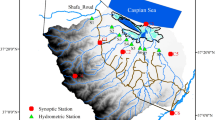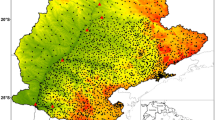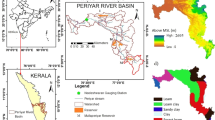Abstract
Human activity has produced severe LULC changes within the Upper Citarum watershed and these changes are predicted to continue in the future. With an increase in population parallel to a 141% increment in urban areas, a reduction of rice fields and the replacement of forests with cultivations have been found in the past. Accordingly, LCM model was used to forecast the LULC in 2029. A distributed model called TETIS was implemented in the Upper Citarum watershed to assess the impact of the different historical and future LULC scenarios on its water and sediment cycles. This model was calibrated and validated with different LULCs. For the implementation of the sediment sub-model, it was crucial to use the bathymetric information of the reservoir located at the catchment’s outlet. Deforestation and urbanization have been shown to be the most influential factors affecting the alteration of the hydrological and sedimentological processes in the Upper Citarum watershed. The change of LULC decreases evapotranspiration and as a direct consequence, the water yield increased by 15% and 40% during the periods 1994–2014 and 2014–2029, respectively. These increments are caused by the rise of three components in the runoff: overland flow, interflow and base flow. Apart from that, these changes in LULC increased the area of non-tolerable erosion from 412 km2 in 1994 to 499 km2 in 2029. The mean sediment yield increased from 3.1 Mton yr−1 in the 1994 LULC scenario to 6.7 Mton yr−1 in the 2029 LULC scenario. An increment of this magnitude will be catastrophic for the operation of the Saguling Dam.










Similar content being viewed by others
References
Agatona M, Setiawan Y, Effendi H (2016) Land use/land cover change detection in an urban watershed: a case study of upper Citarum Watershed, West Java Province, Indonesia. Procedia Environ Sci 33:654–660
Agus F, Wahyunto Watung R L, Talaohu SH, Sutono S (2004) Land use changes and their effects on environmental functions of agriculture. Indonesian Soil Research Institute, Bogor
Alatorre LC, Beguería S, García-Ruiz JM (2010) Regional scale modeling of hill slope sediment delivery: a case study in the Barasona Reservoir watershed (Spain) using WATEM/SEDEM. J Hydrol 391:109–123
Apip K, Takara K, Yamashiki Y, Ibrahim AB (2010) Distributed sediment budget and potential shallow landslide area for investment prioritization in sediment control of catchment : a case study on the Upper Citarum river, Indonesia. Annu Disaster Prev Rest 53:45–59
Arsyad S (2000) Soil and water conservation. IPB pers, Bogor (in Indonesian)
Ayuningtyas DW (2012) Impact analysis of rainfall amount on sedimentation in Upper Citarum watershed with RUSLE2 method. Thesis, Institut Teknologi Bandung (in Indonesian)
Baker TJ, Miller SN (2013) Using the Soil and Water Assessment Tool (SWAT) to assess land use impact on water resources in an East African watershed. J Hydrol 486:100–111
Berti A, Tardivo G, Chiaudani A, Rech F, Borin M (2013) Assessing reference evapotranspiration by the Hargreaves method in North-Eastern Italy. Agric Water Manag 140:20–25
Boongaling CGK, Faustino-Eslava DV, Lansigan FP (2018) Modeling land use change impacts on hydrology and the use of landscape metrics as tools for watershed management: the case of an ungauged catchment in the Philippines. Land Use Policy 72:116–128
Bosmans JHC, Van Beek LPH, Sutanudjaja EH, Bierkens MFP (2017) Hydrological impacts of global land cover change and human water use. Earth Syst Sci 21:5603–5626
Bruijnzeel LA (2004) Hydrological functions of tropical forests: not seeing the soil for the trees? Agric Ecosyst Environ 104:185–228
Bussi G, Rodríguez-Lloveras X, Francés F, Benito G, Sánchez-Moya Y, Sopeña A (2013) Sediment yield model implementation based on check dam infill stratigraphy in a semiarid Mediterranean catchment. Hydrol Earth Syst Sci 17(8):3339–3354
Bussi G, Francés F, Horel E, López-Tarazón JA, Batalla R (2014a) Modelling the impact of climate change on sediment yield in a highly erodible Mediterranean catchment. J Soils Sediments 14(12):1921–1937
Bussi G, Francés F, Montoya JJ, Julien P (2014b) Distributed sediment yield modelling: importance of initial sediment conditions. Environ Model Softw 58:58–70
Calijuri ML, de Siqueira Castro J, Costa LS, Assemany PP, Alves JE (2015) Impact of land use/land cover changes on water quality and hydrological behavior of an agricultural subwatershed. Environ Earth Sci 74(6):5373–5382
Carpenter TM, Gergakakos KP (2006) Intercomparison of lumped versus distributed hydrologic model ensemble simulations on operational forecast scales. J Hydrol 329(1–2):174–185
Chaidar AN, Soekarno I, Wiyono A, Nugroho J (2017) Spatial analysis of erosion and land criticality of the upstream Citarum watershed. Int J GEOMATE 13(37):133–140
Costa MH (2005) Large-scale hydrological impact of tropical forest conversion. In: Bonell M, Bruijnzeel LA (eds) Forests, water and people in the humid tropics: past, present and future. Cambridge University Press, Cambridge, pp 590–597
Cunnane C (1986) Review of statistical models for flood estimation. In: Singh VD (ed) Hydrologic frequency modeling. D. Reidel Pub. Co., Louisiana State University, Baton Rouge
Dasanto DB, Boer R, Pramudya B, Suharnoto Y (2014) Simple method for assessing spread of flood prone areas under historical and future rainfall in the Upper Citarum watershed. Environ Asia 7(1):104–111
De Graff JV, Sidle RC, Ahmad R, Scatena FN (2012) Recognizing the importance of tropical forests in limiting rainfall-induced debris flows. Environ Earth Sci 67(4):1225–1235
Defra (2004) Making space for water developing a new government strategy for flood and coastal erosion risk management in England. Department for Environment, Food and Rural Affairs, London
Dendy FE (1974) Sediment trap efficiency of small reservoirs. J Soil Water Conserv 39(4):278–280
Dharma NGGY, Deguchi C, Yoshitake T (2011) Evaluation of land use plan in Citarum Hulu watershed considering environmental degradation of soil erosion. Miyazaki Univ 40:151–158
Duan Q, Sorooshian S, Gupta VK (1994) Optimal use of the SCE-UA global optimization method for calibrating watershed models. J Hydrol 158(3–4):265–284
Eastman JR (2016) TerrSet manual. Clark University, Worchester
Engelund F, Hansen E (1967) A monograph on sediment transport in alluvial streams. Denmark Tech University, Copenhagen
Fenli Z, Keli T, Cheng-e Z, Xiubin H (2002) Vegetation destruction and restoration effects on soil erosion process on the loess plateau. ISCO conference, pp 208–213
Fonseca R, Pinho C, Oliveira M (2016) The influence of particles recycling on the geochemistry of sediments in a large tropical dam lake in the Amazonian region, Brazil. J S Am Earth Sci 72:328–350
Francés F, Benito J (1995) Floods distributed modeling with few parameters. Ingeniería del Agua 2(4):7–24 (in Spanish)
Francés F, Vélez JI, Vélez JJ (2007) Split—parameter structure for the automatic calibration of distributed hydrological models. J Hydrol 332:226–240
Francés F, Upegui JV, Múnera JC, Medici C, Bussi G et al (2017) Description of the distributed conceptual hydrological model TETIS V.8. Valencia, Spain
Garg V, Aggarwal SP, Gupta PK, Nikam BR, Thakur PK, Srivastav SK, Senthil Kumar A (2017) Assessment of land use land cover change impact on hydrological regime of a basin. Environ Earth Sci 76:635
Ghaffari G, Keesstra S, Ghodousi J, Ahmadi H (2010) SWAT-simulated hydrological impact of land-use change in the Zanjanrood basin, Northwest Iran. Hydrol Process 24(7):892–903
Gupta A (2011) Tropical geomorphology. Cambridge University Press, New York
Gyamfi C, Ndambuki J, Salim R (2016) Hydrological responses to land use/cover changes in the Olifants basin, South Africa. Water 8(12):588
Hammer WI (1981) Second soil conservation consultant report. Centre for Soil Research, Bogor
Happ M (2014) Impacts of land-cover change and high rainfall on soil erosion among three farms in Cerro Punta, Chiriquí, Panamá. College of Wooster, Panama
Harlan D, Wangsadipura M, Munajat CM (2009) Determination of daily discharge using rainfall runoff GR4 J model for hydrograph unit analysis in Upper Citarum watershed. Jurnal Teknik Sipil 16(1):1–12 (in Indonesian)
Hidayat Y, Murtilaksono K, Wahjunie ED, Panuju DR (2013) The characteristics of river discharge of Citarum Hulu. Jurnal Ilmu Pertanian Indonesia 18(2):109–114 (in Indonesian)
ICALRRD (1993) Optimisation of land usage in watershed report. Badan Penelitian dan Pengembangan Pertanian, Bogor (in Indonesian)
Ilyas MA (2002) Sedimentation and its impact on Upper Citarum watershed. Jurnal Teknologi Lingkungan 3(2):159–164 (in Indonesian)
Julian MM, Fink M, Fischer C, Krause P, Flügel WA (2013) Implementation of J2000 hydrological model in the Western part of Java Island, Indonesia. J MacroTrends Appl Sci 1(1):1–25
Julien PY (2010) Erosion and sedimentation. Cambridge University Press, Cambridge
Julien P, Rojas R (2002) Upland erosion modeling with CASC2D-SED. Int J Sediment Res 17(4):265–274
Kheereemangkla Y, Shrestha RP, Shrestha S, Jourdain D (2016) Modeling hydrologic responses to land management scenarios for the Chi river sub-basin part II, Northeast Thailand. Environ Earth Sci 75(9):793
Kilinc M, Richardson E (1973) Mechanics of soil erosion from overland flow generated by simulated rainfall. Colorado State University, Colorado
Klemes V (1986) Operational testing of hydrological simulation models. Hydrol Sci J 31(1):13–24
Kottegoda N, Rosso R (2008) Applied statistics for civil and environmental engineers. The McGraw-Hill Companies Inc, Milan
Legesse D, Coulumb CV, Gasse F (2003) Hydrological response of a catchment to climate and land use changes in Tropical Africa: case study South Central Ethiopia. J Hydrol 275(1–2):67–85
Leh M, Bajwa S, Chaubey I (2013) Impact of land use change on erosion risk: an integrated remote sensing, geographic information system and modeling methodology. Land Degrad Dev 24:409–421
Loi NK (2010) Assessing the impacts of land use/land cover changes and practices on water discharge and sedimentation using SWAT: case study in Dong Nai watershed—Vietnam. International symposium on geoinformatics for spatial infrastructure development in earth and allied sciences, Vietnam
Marhaento H, Booij MJ, Hoekstra AY (2018) Hydrological response to future land-use change and climate change in a tropical catchment. Hydrol Sci J 63:1368–1385
Mauliana P (2016) Flood prediction in Citarum using Fuzzy logic from particle Swarm optimization algorithm. Jurnal Informatika 3(2):269–276 (in Indonesian)
Miller CR (1953) Determination of the unit weight of sediment for use in sediment volume computations. Bureau of Reclamation, Denver
Ministry of Public Works (2011) TA 7189-INO: Institutional strengthening in the 6 ci’s river basin territory - package B for integrated water resources management (IWRM). Bandung, Indonesia
Mir SI, Ismail BS, Tayeb MA (2016) Hydrology and sediment loading in a degrading natural lake system in Malaysia. Environ Earth Sci 75(3):231
Mohammad AG, Adam MA (2010) The impact of vegetative cover type on runoff and soil erosion under different land uses. CATENA 81(2):97–103
Molion LCB (1993) Amazonian rainfall and its variability. In: Bonell M, Hufschmidt MM, Gladwell JS (eds) Hydrology and water management in the humid tropics: hydrological research issues and strategies for water management. Cambridge University Press, New York, pp 55–62
Moriasi DN, Arnold JG, Van Liew MW, Bingner RL, Harmel RD, Veith TL (2007) Model evaluation guidelines for systematic quantification of accuracy in watershed simulations. Trans ASABE 50(3):885–900
Mushtaq F, Lala MGN (2017) Assessment of hydrological response as a function of LULC change and climatic variability in the catchment of the Wular Lake, J&K, using geospatial technique. Environ Earth Sci 76(22):760
Naabil E, Lamptey BL, Arnault J, Olufayo A, Kunstmann H (2017) Water resources management using the WRF-Hydro modelling system: case-study of the Tono dam in West Africa. J Hydrol Reg Stud 12:196–209
Nagle GN, Fahey TJ, Lassoie JP (1999) Management of sedimentation in tropical watersheds. Environ Manag 23(4):441–452
NASA (1976) U.S. Standard atmosphere, 1976. US Government Printing Office, Washington DC, United States of America
Nurliani, Rosada I (2016) Rice-field conversion and its impact on food availability. Agric Agric Sci Procedia 9:40–46
Peña LE, Barrios M, Francés F (2016) Flood quantiles scaling with upper soil hydraulic properties for different land uses at catchment scale. J Hydrol 541:1258–1272
Poerbandono P, Ward PJ, Julian MM (2009) Set up and calibration of a spatial tool for simulating river discharge of Western Java in recent decades: preliminary results and assessments. J Eng Technol Sci 41(1):50–64
Price K (2011) Effects of watershed topography, soils, land use, and climate on baseflow hydrology in humid regions: a review. Phys Geogr 4:465–492
Rogger M, Agnoletti M, Alaoui A, Bathurst JC, Bodner G, Borga M, Chaplot V, Gallart F, Glatzel G, Hall J, Holden J, Holko L, Horn R, Kiss A, Kohnová S, Leitinger G, Lennartz B, Parajka J, Perdigão R, Peth S, Plavcová L, Quinton JN, Robinson M, Salinas JL, Santoro A, Szolgay J, Tron S, van den Akker JJH, Viglione A, Blöschl G (2017) Land use change impacts on floods at the catchment scale: challenges and opportunities for future research. Water Resour Res 53(7):5209–5219
Saxton KE, Rawls WJ (2006) Soil water characteristic estimates by texture and organic matter for hydrologic solutions. Soil Sci Soc Am J 70:1569–1578
Sinha RK, Eldho TI (2018) Effects of historical and projected land use/cover change on runoff and sediment yield in the Netravati river basin, Western Ghats, India. Environ Earth Sci 77(3):1–19
Siswanto SY (2010) Land degradation assessment in West Java Island, Indonesia. Thesis, Ghent University
Tarigan SD, Tukayo RK (2013) Impact of land use change and land management on irrigation water supply in Northern Java coast. J Trop Soils 18(2):169–176
Tommi (2011) The impact of land use on hydrological charactersitic in Upper Citarum watershed. Thesis, Bogor Insitute of Agriculture (in Indonesia)
Vaighan AA, Talebbeydokhti N, Bavani AM (2017) Assessing the impacts of climate and land use change on streamflow, water quality and suspended sediment in the Kor River Basin, Southwest of Iran. Environ Earth Sci 76(15):1–18
Verstraeten G, Poesen J, de Vente J, Koninckx X (2003) Sediment yield variability in Spain: a quantitative and semiqualitative analysis using reservoir sedimentation rates. Geomorphology 50:327–348
Wheater H, Evans E (2009) Land use, water management and future flood risk. Land Use Policy 26:251–264
Wibowo M (2011) Statistical model of river discharge and sediment relation, study case in Citarum-Nanjung watershed. Jurnal Teknologi Lingkungan 2(3):255–260 (in Indonesian)
Wischmeier WH, Smith DD (1961) A universal equation for predicting rainfall-erosion losses: an aid to conservation farming in humid regions. Agricultural Research Service USDA, Washington DC
Wischmeier WH, Johnson CB, Cross BV (1971) A soil erodibility nomograph for farmland and construction sites. J Soil Water Conserv 26:189–193
Wohl E, Barros A, Brunsell N, Chappell NA, Coe M, Giambelluca T, Goldsmith S, Harmon R, Hendrickx JMH, Juvik J, Mcdonnell J (2012) The hydrology of the humid tropics. Nat Clim Change 2:655–662
Xu C (2002) Hydrologic models. Uppsala University, Sweden
Yu B, Zhang G, Fu X (2015) Transport capacity of overland flow with high sediment concentration. J Hydrol Eng 20(6):1–10
Zare M, Panagopoulos T, Loures L (2017) Simulating the impacts of future land use change on soil erosion in the Kasilian watershed, Iran. Land Use Policy 67:558–572
Zhang L, Dawes WR, Walker GR (2001) Response of mean annual evapotranspiration to vegetation changes at catchment scale. Water Resour Res 37(3):701–708
Zuazo VHD, Pleguezuelo CRR (2008) Soil-erosion and runoff prevention by plant covers. Agron Sustain Dev 28(1):65–86
Acknowledgements
This study was partially funded by the Spanish Ministry of Economy and Competitiveness through the research projects TETISMED (CGL2014-58,127-C3-3-R) and TETISCHANGE (RTI2018-093717-B-I00). The authors are also thankful to the Directorate General of Higher Education of Indonesia (DIKTI) for the Ph.D. funding of the first author.
Author information
Authors and Affiliations
Corresponding author
Additional information
Publisher's Note
Springer Nature remains neutral with regard to jurisdictional claims in published maps and institutional affiliations.
Rights and permissions
About this article
Cite this article
Siswanto, S.Y., Francés, F. How land use/land cover changes can affect water, flooding and sedimentation in a tropical watershed: a case study using distributed modeling in the Upper Citarum watershed, Indonesia. Environ Earth Sci 78, 550 (2019). https://doi.org/10.1007/s12665-019-8561-0
Received:
Accepted:
Published:
DOI: https://doi.org/10.1007/s12665-019-8561-0




